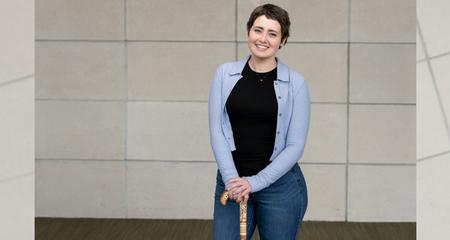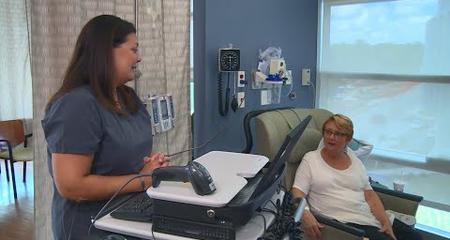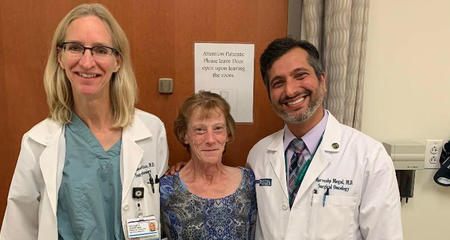Only about 2,300 new cases of primary bone cancer (sarcoma) are diagnosed each year in the United States, so it is quite rare. This is in contrast to roughly 250,000 newly diagnosed cases of lung cancer a year. Bone cancer is a malignant tumor of the bone that grows, compressing and destroying bone tissue. Its cause is relatively unknown, but individuals who have had certain kinds of radiation therapy or chemotherapy can be at increased risk. In the vast majority of patients, there is no known cause.
However, in some patients, there can be a hereditary or genetic link. Certain genetic syndromes, such as Li-Fraumeni or hereditary retinoblastoma (among others) can make individuals from the same family more susceptible to developing bone sarcoma. The most common symptom is persistent or unusual pain or swelling in or near a bone.
Types of Bone Cancer (Sarcoma)
The most common types of bone cancer include the following:
- Osteosarcoma: typically occurs in the bones around the knee and upper arm
- Chondrosarcoma: originates in the cartilage that cushions the ends of bones and lines the joints; most often occurs in the pelvis, upper leg and shoulder.
- The Ewing Sarcoma Family of Tumors: these usually occur in bone, but may also be present in connective tissue; typically located in the pelvis, legs and arms.
- Multiple Myeloma: A cancer of plasma cells that originates in bones
Diagnosing Bone Cancer
In addition to a patient's personal and family medical history and a physical exam, the physician may recommend one or more of the following diagnostic studies:
X-rays: to image various areas of the body and show the location, size and shape of a bone tumor.
- Bone scans: a small amount of radioactive material is injected into the bloodstream, travels to the bones and is detected by a scanner. Used to identify possible tumors in other bones.
- CT scans: cross-sectional images that can reveal if a tumor has spread
- MRI scans: use magnetic energy to produce detailed pictures inside the body without X-rays
- PET scans: image the body's metabolic action to show if cancer has spread
- Biopsy: the removal of small tissue samples or cells through a needle biopsy or incisional biopsy; the only certain way to make a diagnosis of cancer.
Treating Bone Cancer
Surgery plays a primary role in the treatment of bone cancer (sarcoma). Medical oncology and radiation oncology may also be part of the treatment plan.
Bone Cancer Surgery
The goal of surgery is twofold: remove the cancerous tumor and restore physical function and appearance. The skill of our plastic surgeons and the unique procedures they have developed, allow cancer surgeons to be aggressive in removing cancerous bone. In bone tumor surgery, it is absolutely critical that a “cuff” of normal tissue is taken from around the tumor cells to minimize the risk of the tumor recurring at the local resection site. The surgeons at Froedtert & the Medical College are specially trained to remove cancers and achieve safe "margins" in surgery. This helps assure that all of the cancer was removed to prevent recurrence.
Unlike other facilities that perform multiple surgeries on a patient, we have perfected the technique of completing cancer and reconstructive surgeries in a single operation, whenever possible. When the cancer team finishes, the reconstructive team begins its delicate task of replacing bone. Musculoskeletal oncologists and plastic surgeons use donor (cadaver) bone, the patient’s own bone from other sites and metal implants to reconstruct limbs and restore function. Occasionally, they use "donor" bone from the patient's fibula and remove a section along with associated blood vessels for implantation to the cancer site. Replacement bone provides strength, rigidity and nourishment to transplanted blood vessels, so new bone will grow and the patient can return to a pre-surgical state.
We make every effort to streamline and optimize the care of patients with bone and soft tissue sarcomas. Patients scheduled for surgery are evaluated by the Pre-admission Testing team to ensure surgery is done as safely as possible and any peri-operative questions are answered completely. Following surgery, a team (including doctors, nurse practitioners, and physician assistants with specialized expertise in the medical management of the complex tumor patient) works hand-in-hand with the surgical team to optimize the care of this challenging and unique patient population.
Plastic Surgery
After a patient has had surgery to remove a sarcoma, plastic surgeons use specialized surgical techniques to replace tissue and close the surgical wound.
The goal of plastic surgery is to restore the most natural appearance and functioning of soft tissues (skin, fat, blood vessels and nerves). The plastic surgeon may use tissue from other areas of the body to provide natural coverage of exposed artificial joints, bones, blood vessels and nerves. The donor tissue may come from the abdomen, thigh or back. When possible, surgery to remove the cancer and reconstructive surgery are performed in a single operation.
Read more about plastic surgery’s important role in treating bone cancer.
Medical Oncology
Our Sarcoma Program team may also recommend chemotherapy to treat bone cancer. It may be administered before surgery to shrink the tumor, or subsequently to minimize the risk of the cancer occurring elsewhere in the body. As a secondary modality in treating bone cancer, chemotherapy is considered adjuvant therapy. Patients who present for treatment with disease that has spread to other sites will generally receive chemotherapy.
Radiation Oncology
Radiation therapy is less commonly utilized to treat bone cancer. If resection (surgery) of the bone tumor is not possible, radiation therapy may be an alternative.
Virtual Visits Are Available
Safe and convenient virtual visits by video let you get the care you need via a mobile device, tablet or computer wherever you are. We’ll gather your medical records for you and get our experts’ input so we can offer treatment options without an in-person visit. To schedule a virtual visit, call 1-866-680-0505.
More to Explore





